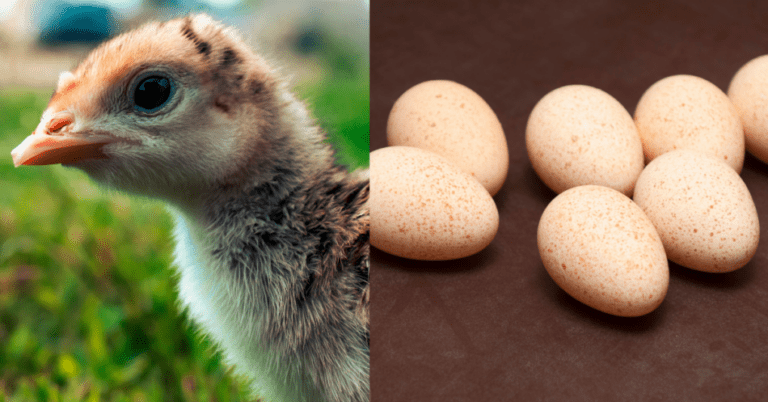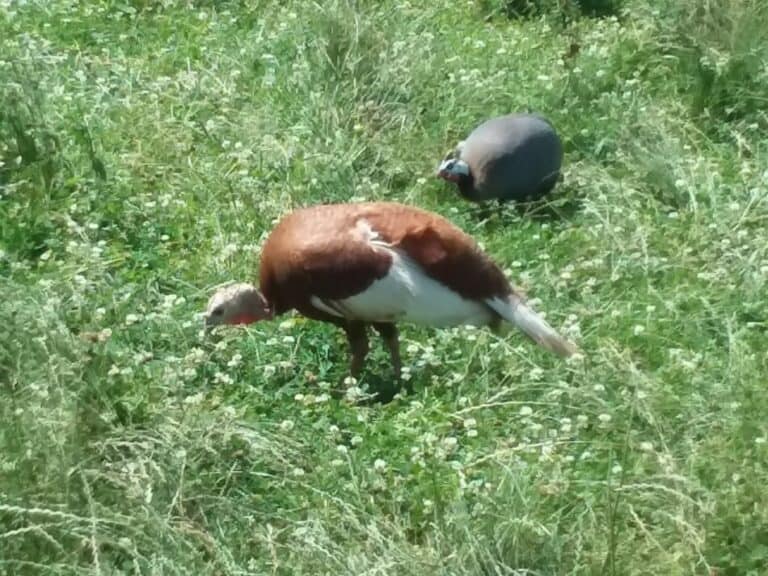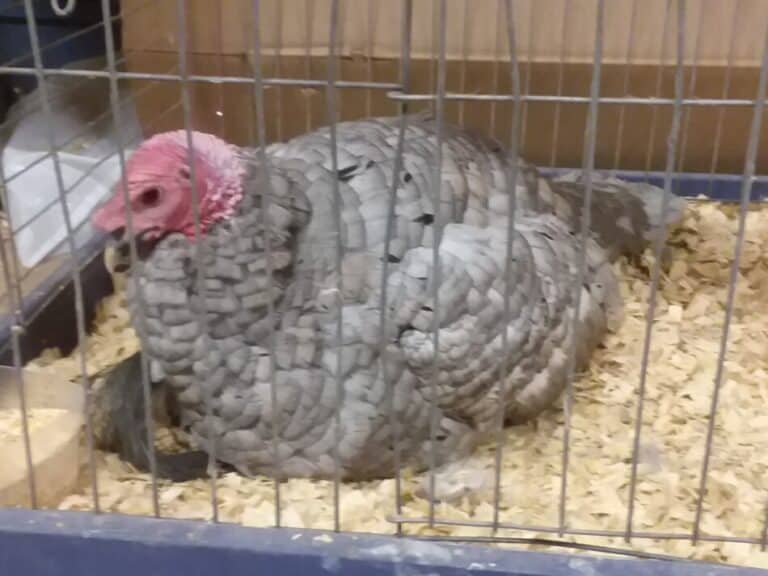When Is It Safe To Let Turkey Poults Outside?

Your turkey poults are growing like crazy and they look pretty big in that brooder! The next step in the plan is to put the poults outside, but how can you tell if they are ready?
When are turkey poults big enough to go outside and what’s the best way to transition them to living outside?
Turkey poults can go outside to a protected area when they are 6-7 weeks old, fully feathered and the ambient temperature is 65 degrees or higher. In colder or harsh weather, the poults need to be kept inside longer.
Is Raising Your Own Turkey Worth It? will go over the budgeting for raising turkeys for meat.
If you don’t have your poults yet, read 4 Ways To Get Turkey Poults To Eat And Drink for tips on your first few days with turkeys.
Turkey poults can go outside at 6-7 weeks of age
Your turkey poults can go outside when they are 6-7 weeks old and fully feathered. The “fully feathered” part is the key here. If you still see the fluffy baby feathers, your poults still need the brooder.
The outside temperature must be close to the temperature of the brooder that the poults just came out of. Don’t forget about overnight temperatures, too!
When the outside temperature is low, noticeably lower than the brooder temperature the poults are used to, they will have a hard time adjusting, which is stressful.
Part of the adjustment to outside temperatures is lowering the brooder temperature by 5 degrees per week, as the turkeys grow. When the brooder temperature gets close to the ambient temperature, the poults can go outside.
There are two key points in that last paragraph, lowering brooder temperature and poults going outside, let’s dig deeper into each.
Lowering brooder temperature: you should be lowering the brooder temperature by 5 degrees every week.
Start the brooder temperature off at 95 degrees, as measured by a thermometer placed an inch or two off of the ground in the brooder, right in poult range. (Take thermometer out of brooder, just use it to check temps.)
Each week reduce the temperature in the heated zones of the brooder by 5 degrees.
You can lower brooder temperature by raising the heat lamp off of the floor until the thermometer reads the new temperature you need.
| Age of turkey poults | Brooder temperature |
| First week, poults 1-7 days old | 95 |
| Second week | 90 |
| Third week | 85 |
| Fourth week | 80 |
| Fifth week | 75 |
| Sixth week | 70 |
| Seventh week | 65 |
You’ll notice that by the time you get your poults to 6-7 weeks of age, their temperature needs and the outside temperatures are likely to be within a close range.
This is the reason why your birds can go outside at this age and the fact that they are fully feathered!
If the difference between the brooder temperature and the outside temperature is too great, your poults will have a hard time adjusting to the change.
All this additional stress equals poor doers and, sadly, poor doers in turkey poults tend to die rather than get better.
If the weather forecast looks promising, put the poults out, if the forecast looks rough, figure out how to expand their brooder area and keep them inside until they are older and can handle the weather conditions in your area.
Here’s a nice article on Turkey Brooding 101 from Meyer Hatchery, if you want more details or an equipment list.
The outside pen needs to be turkey proof
When you put your poults outside, they need to go into an outside pen or coop area that is poult proof. Do not just let them loose to roam as they please, it will end badly!
Think of the outside pen as more of a playpen rather than full freedom, they are not ready to be fully roaming yet.
The outside pen needs to be turkey proof, by that I mean wire mesh that is small enough they can not squeeze themselves out of it, and if you have heritage birds, you might need a higher fence, since they can fly.
To be clear, heritage turkeys can not fly well enough to “go south for the winter” but they can easily fly well enough to make it up into trees or roost in the rafters of a shed.

The turkey pen needs to be predator free
The outside turkey pen needs to be kept predator free. What I mean by that is that your poults had the protection of the brooder while they were inside, now they are looking like easy snacks for ground and aerial predation.
Aerial predation: predation from the air will be hawks or any hawk like bird in your area.
If you have an aggressive hawk population, you may need to keep your poults in a outdoor run with a covered top. Shade cloth or more of the perimeter fence will work to keep out the hawks.
Ground predation: most predators are attempting to get ahold of your poults by sneaking in the fenced in area. The easy fix here is to have a mesh fence, like welded wire, that will keep in the poults and keep out the predators.
Even your dog “play chasing” the poults is a predatory action to the poults. Keep your dog out of your poults and away from the perimeter fence of their area, as well.
Some predators, like weasels or mink, are super aggressive at getting through wire and will be tough to stop. Most predators will try to get something easier if your poults are well protected.
To be clear, I’m talking about smaller predators, like raccoons and skunks, if you have something larger like a bear harassing your birds, you’ll need to keep your poults in a much more secure area, like a barn.
Outside turkeys need feed and water
Once your poults are old enough to go outside they still need care, with shelter, feed and water are topping the list.
Remember, until your poults are fully grown, you are taking the place of their mom, making sure they are safe and getting plenty to eat and drink.
Turkey poults should be on full feed until they are grown
Turkeys are good grazers and love to poke around eating grass and bugs, but they still need to free choice feed until they are fully grown, or in the case of broad breasted birds, the entire time you have them.
The specific feed they need will change as they grow, it will go down in protein and will be in pellets or ground rather than the crumbles they go when they were newly hatched poults.
Feed For Turkeys will go over the different stages of feed for your poults, please stick to the chart! The turkeys grow so quickly they need to have high level nutrition to support that growth.
Know that other birds will want the turkey feed, as well. Your chickens will be in with the poults, stealing feed if they can.
You’ll want to keep the chickens out of the turkey feed. True, the poults are bigger than the chickens, but they are not more aggressive!
Turkey poults need plenty of clean, fresh water
Your poults need easy access to water, especially when they are on free choice feed!
If you are not home during the day to monitor the water levels, make sure the waterer has plenty of capacity to make it through the entire day without needing refilled.
The importance of water is often overlooked, but is needed in higher amounts than the feed! Be sure your poults have plenty.
A side note: if you have ducks or other waterfowl, they will mess around in any water they can get their bills into, your turkey waterer included. Keep waterfowl out of the turkey pen, so the poults have clean water available.
Turkey poults need shelter
Even though your poults are big enough to be outside, they still need shelter, especially from the rain or harsh winds!
The younger your poults are the more of a problem harsh weather will be for them to handle.
Being caught out in the rain is a big deal, it will kill younger poults. Some will be found dead, others will die a day or two later from the stress. Make sure this doesn’t happen to yours.
Turkey poults need shade
Turkeys also need shade, especially in the hotter parts of the year.
We have a lot of free roaming birds around here, turkeys included and in the hottest part of a summer day, they are all hanging out in a shady spot waiting for the cooler evening temperatures before they come out and eat.
The reason I listed shade separately from shelter is that frequently the small building that is great for the rest of the year is smoking hot inside during a summer day.
Your turkeys need somewhere cooler to relax in the heat of the day.
How can you tell if it’s too hot in your shelter? Hop in and see! If you are hot, so are your poults, put them somewhere more comfortable.



